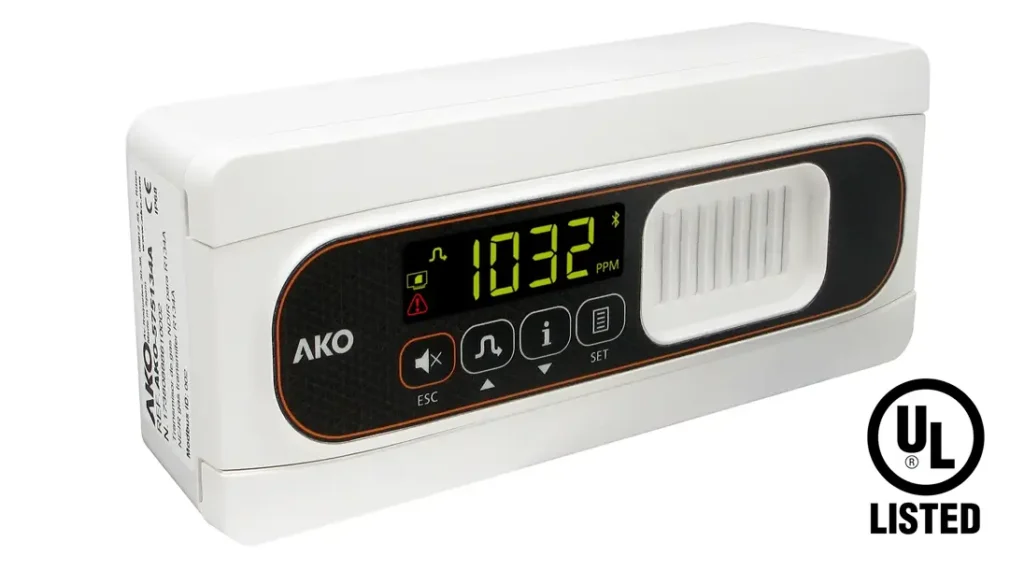
Fugitive Emissions are the Future of ESG Reporting
We talk endlessly about carbon dioxide, about air pollution, about natural gas.
Companies trumpet their ESG disclosures with dashboards, metrics, and carefully worded pledges.
Yet, amid all this noise, fugitive emissions (especially from refrigerants) remain invisible.
And that invisibility is dangerous.
These leaks aren’t minor. They represent a staggering share of hazardous air pollutants and greenhouse gases: quiet, unmeasured or poorly estimated failures in the systems we rely on every day, from data centers to supermarkets.
So why speak about this now?
Because California’s SB 219 is coming, and it will change everything about how these emissions are counted, verified, and reported. For some companies, it will be a wake-up call. For others, a reckoning.
For years, the Clean Air Act set the legal foundation, but the law alone isn’t enough. What’s missing is rigour: the kind defined by ISO standards and the Greenhouse Gas Protocol.
Without those frameworks, data is guesswork, and guesswork no longer satisfies regulators or investors. Rigorous assessment is now essential for quantifying fugitive emissions and ensuring regulatory compliance.
The world is moving toward precision (resilience), not pledges. SB 219 makes that shift explicit. It demands more than awareness; it demands quantification. For companies still treating refrigerant losses as rounding errors, this is the moment of truth.
ISO and the GHG Protocol provide the structure; SB 219 delivers the consequence.
📌 Together, they make one fact impossible to ignore
If you can’t measure your leaks, you can’t manage your emissions, and soon, you won’t be allowed to ignore them..
Table of Contents
ToggleIntroduction to Fugitive Emissions
Fugitive emissions: those unintentional releases of gases or vapors from pressurized equipment, storage tanks, refrigeration systems, and industrial facilities are often overlooked, yet they represent a significant slice of total emissions, as these sources can emit hydrocarbons and other pollutants.
The oil and gas industry stands as a major source, with natural gas wells and storage tanks frequently implicated. But increasingly, attention turns to refrigerant emissions from cooling systems, potent greenhouse gases that contribute heavily to climate change. Hydrofluorocarbons (HFCs) and hydrochlorofluorocarbons (HCFCs), common in air conditioning and refrigeration, leak silently yet powerfully.
Leakage from valves, flanges, and fittings is a primary pathway for fugitive emissions in industrial settings.
The Environmental Protection Agency (EPA), under the Clean Air Act, seeks to clamp down on these invisible offenders, aiming to reduce air pollution and greenhouse gases from oil, gas, refrigeration, and other industrial sources.
The stakes are high: these leaks pose real risks to our environment and health.

Fugitive Emissions as Non-Financial Data Disclosure Responsibilities
Now, fugitive emissions have stepped into the spotlight of non-financial disclosure frameworks. The EU’s Non-Financial Reporting Directive (NFRD) and the forthcoming Corporate Sustainability Reporting Directive (CSRD) demand transparency on greenhouse gases and pollutants impacting climate and health.
Across the Atlantic, the U.S. Securities and Exchange Commission (SEC) is relaxing mandatory disclosures of Scope 1, 2, and 3 greenhouse gas emissions, fugitive emissions included, while at the very same time California has signed into law mandatory reporting requirement that will at the very least require the top 5000 companies to accurately disclose their emissions and most likely will impact more than 45,000 companies globally.
What was once voluntary is becoming compulsory. Materiality assessments weigh in: given the environmental and health stakes, fugitive emissions are increasingly material information.
Companies must now gather accurate data, verify it, and disclose accordingly—no more hiding in the shadows.
→ Discover our HVAC/R Knowledge Hub
CARB’s SB 253 and SB 261 Reporting Templates: Preparing for 2026 and 2027
California’s Air Resources Board (CARB) has rolled out draft reporting templates for Senate Bills 253 and 261, setting a standardized path for Scope 1 and 2 GHG disclosures.
These templates align with the GHG Protocol and are voluntary for 2026 and 2027 filings. SB 253 compliance targets large U.S. companies doing business in California, with initial reports due June 30, 2026. SB 261 extends to large private firms, with reports due a year later.
Third-party assurance will kick in shortly thereafter.
The templates cover organizational details, verification, emission factors, and much more—laying the groundwork for rigorous, transparent reporting.
The California Corporate Greenhouse Gas Reporting Program: A Comprehensive Overview
The California Corporate Greenhouse Gas Reporting Program, authorized by Senate Bill (SB) 253 (Wiener, 2023), represents a landmark regulatory initiative aimed at enhancing transparency and accountability for greenhouse gas (GHG) emissions among major business entities operating in California.
Developed by the California Air Resources Board (CARB), this program mandates that reporting entities (defined as business organizations established under the laws of California, any other U.S. state, the District of Columbia, or under federal law) with total annual revenues exceeding one billion dollars ($1,000,000,000) and conducting business within California, disclose their annual Scope 1, Scope 2, and Scope 3 GHG emissions for the preceding fiscal year.
To unpack this further, Scope 1 emissions refer to direct GHG emissions from sources owned or controlled by the company, such as combustion of fossil fuels on-site. Scope 2 emissions cover indirect emissions resulting from the generation of purchased electricity, steam, heating, or cooling consumed by the company.
Scope 3 emissions are broader and encompass all other indirect emissions occurring in the company’s value chain, including upstream and downstream activities like transportation, waste disposal, and product use.
Complementing SB 253, Senate Bill 261 (Stern, 2023) authorizes the Climate-Related Financial Risk Disclosure Program, which extends its reach to both public and private U.S. companies with annual revenues of $500 million or more doing business in California.
This program, also under development by CARB, requires these companies to publish biennial reports detailing climate-related financial risks, thereby integrating environmental considerations into financial disclosure frameworks.
Do you want to learn more about fugitive emissions and ESG reporting?
Together, these programs are designed to foster a culture of transparency that empowers consumers and investors with reliable, standardized data on corporate GHG emissions and climate-related financial risks.
This transparency is crucial for informed decision-making, enabling stakeholders to assess environmental impact and financial exposure related to climate change.
Importantly, CARB is committed to ensuring that these reporting requirements are implemented with minimal administrative burden, balancing the need for rigorous data collection with practical considerations for businesses.
The program’s draft Scope 1 and 2 GHG Reporting Template, posted on October 10, 2025, exemplifies this approach by providing a clear, structured framework to facilitate compliance.
In essence, the California Corporate Greenhouse Gas Reporting Program and the Climate-Related Financial Risk Disclosure Program mark a significant step forward in regulatory oversight, aligning environmental responsibility with financial transparency to drive meaningful progress in combating climate change.
Enhancing Emissions Monitoring with Automated Emissions Observations (AEO)
As these reporting demands grow, Automated Emissions Observations (AEO) systems emerge as a game-changer. Real-time monitoring means leaks are detected instantly, allowing swift action.
Continuous data flow enhances accuracy and reduces reliance on manual checks. It’s not just compliance; it’s operational excellence.

Beyond Oil and Gas: The Refrigeration Reckoning
Refrigeration systems (not oil or gas) are now among the largest and least-reported sources of fugitive greenhouse gas emissions.
We love to point at oil. We love to blame gas. And when we run out of villains, we turn our outrage toward private jets. It’s familiar, easy, and comfortable.
But while we fixate on combustion, the real climate damage is leaking quietly out the back of every supermarket, data center, and hospital.
Refrigeration and Air COnditioning are the great omission in the emissions debate.
Every system that cools our food, preserves our vaccines, or keeps our servers from melting depends on hydrofluorocarbons (HFCs) and hydrochlorofluorocarbons (HCFCs), gases thousands of times more potent than carbon dioxide.
They escape through worn seals, aging valves, and neglected systems.
They are invisible, odorless, and devastatingly effective at trapping heat.
According to the U.S. Greenhouse Gas Inventory (2023), refrigerants account for nearly 15% of all carbon-related emissions.
In grocery and cold-storage operations, refrigerant leaks often represent more than half of total Scope 1 emissions; more than trucks, fuel, or power combined.
These are not rounding errors; they are operational failures with planetary consequences.
The legislation has caught up.
California’s SB 219, SB 253, and SB 261 demand verifiable data, not optimistic estimates.
Under ISO 14064 and the Greenhouse Gas Protocol, companies must now trace every pound of refrigerant purchased, charged, or lost. This is what precision looks like: traceable molecules, not moral statements.
📌 For years, we treated fugitive refrigerant emissions as background noise.
Now, regulators and investors are tuning in, and they expect proof.
Continuous monitoring, digital leak detection, and integrated reporting systems already exist.
The question isn’t “Can we see the leaks?” It’s “Why haven’t we cared enough to stop them?”
We can’t keep hiding behind the easy narratives of oil, gas, and aviation.
Refrigeration is the climate story no one wanted to tell, but it’s the one that will determine whether ESG reporting stands for accountability or collapses under hypocrisy.
Because until we can keep what we cool, every climate promise is just another puff of hot air.
→ Discover our HVAC/R Knowledge Hub

Climate Change Impacts
These emissions linger, trapping heat and driving global warming.
Most fugitive emissions are released accidentally and contribute significantly to climate change.
They must be accounted for in all emission scopes, not dismissed as mere lost commodities. Accurate accounting is pivotal for managing environmental impact.
Regulatory Focus: EPA and Fugitive Emissions
The EPA highlights fugitive emissions, especially from HVAC and refrigeration, as significant GHG sources.
Their oversight aims to curb these emissions, given their outsized impact on climate and air quality.
Certain fugitive emissions, such as CFCs and halons, can damage the ozone layer, which protects the Earth from harmful ultraviolet radiation.
For decades, the EPA has been at the forefront of policy development, but now it shares the spotlight and the oversight with many states like California, Massachusetts, Colorado, New Jersey, New York, Washington, and many others.
And we expect more of this.
→ Learn more about how you can streamline your compliance journey.

Refrigerant Emissions: The “Cinderella” of Fugitive Emissions
Once overlooked, refrigerant emissions now stand as a top climate mitigation opportunity.
Project Drawdown ranks refrigerant management highest among solutions, supported by IPCC findings that halogenated gases account for about 10% of historical warming.
Despite international agreements like the Kigali Amendment and national laws such as the AIM Act, gaps remain.
The world’s commitment is strong, but the pace of change must accelerate to keep warming below 1.5°C.
Materiality and Reporting of Fugitive Emissions
Materiality guides reporting: for large firms, fugitive emissions are usually material.
Trakref notes that refrigerant leaks exceeding 1% of Scope 1 and 2 emissions signal material risk. Retailers like Dollar Tree lead with detailed disclosures, reporting fugitive emissions as a majority of their Scope 1 footprint—a model of transparency.
Growing ESG Investment and the Importance of Fugitive Emissions
ESG investing remains alive, if not in the shadows. Investors demand clear, consistent emissions data. Addressing fugitive emissions enhances transparency and aligns companies with shared ESG goals.
They do this not for altruistic purposes but because savvy investors have figured out that the non-financial data exposes the vulnerabilities and risks a company has hidden on its balance sheet.

Ready to upgrade your leak detection program? Get the AKOGAS NDIR Leak Detector
Reducing Fugitive Emissions: Tools and Strategies
Reporting is just the start. Cutting emissions protects the environment and meets investor expectations. Storage tanks are a key focus.
Leak Detection tools like these are deployed as part of the joint effort between AKO and Carbcon Connector to support maintenance, tracking, and evaluation, empowering informed action.
The process of managing fugitive emissions involves an integrated workflow of leak detection, maintenance, and reporting to ensure compliance and operational efficiency.
Don’t Fall Behind on Fugitive Emissions Reporting
Fugitive emissions are a climate factor no company can ignore. With regulations tightening and investor scrutiny rising, early preparation is vital to lead, not lag.
How Carbon Connector Supports Emissions Management
Carbon Connector bridges regulatory demands and operational reality. Their tools include:
- Refrigerant leak detection with AKO NDIR sensors and Leak Detection as a Service (LDaaS).
- Digital asset tagging aligned with CARB facility IDs.
- Integration of maintenance, energy, and leak data for accurate reporting.
- Continuous monitoring that replaces last-minute reporting with proactive management.
- Embedding these capabilities transforms compliance into actionable insight.
Embracing Real-Time Leak Detection and Tracking
Infrared cameras, ultrasonic detectors, and continuous sensors enable early leak detection, cutting greenhouse gases and operational risks.
These technologies support compliance and environmental stewardship.
Addressing Other Fugitive Emission Sources
Methane from gas wells, fugitive dust from unpaved roads, and industrial activities also contribute.
Holistic strategies must tackle all significant sources.
Do you want to learn more about fugitive emissions and ESG reporting?
Scientific Research and Industry Data on Fugitive Emissions
Studies in the International Journal and Geophysical Research Letters underscore fugitive emissions’ growing climate impact.
The Climate Chance report highlights the oil and gas industry’s methane emissions and policy implications. Early adopters of advanced monitoring set the pace for environmental leadership.
Economic and Safety Risks of Fugitive Emissions
Leaks mean lost commodities and heightened explosion risks. Proactive detection and maintenance protect assets, personnel, and regulatory standing.
Stakeholder Engagement and Fugitive Emissions
Reducing fugitive emissions demands collaboration. The EPA sets standards and enforces compliance; the Environmental Defense Fund drives research and innovation. Industry players, government, environmental groups, and communities must unite to reduce emissions and protect air quality.
Enhancing ESG Reporting with Accurate Emission Data
Integrating real-time refrigerant leak data into ESG reports delivers transparency and verifiable impact, supporting compliance with the Clean Air Act and EPA expectations.
The message is clear: if you can’t measure your leaks, you can’t manage your emissions.
Future Directions for Fugitive Emissions Management
Looking ahead, the management of fugitive emissions will be central to achieving climate goals and reducing total emissions worldwide.
The EPA’s office estimates that advancements in monitoring, detection, and emission-reducing technologies can deliver substantial reductions in fugitive emissions.
Recent years have seen a surge in innovative solutions, from real-time monitoring systems to aerosol-based technologies, all designed to address the unique challenges of fugitive emissions.
As regulations tighten and the world moves toward a low-carbon future, prioritizing effective emissions management will be essential.
By embracing new technologies and robust monitoring, industries can play a pivotal role in mitigating climate change and ensuring a sustainable future for all.
Heard Enough?
We’ve measured, modelled, and promised, but leaks keep laughing at our paperwork. We can no longer hide behind dashboards and pledges while refrigerant escapes into the air and credibility drains out with it.
We’ve had enough. Enough pretending the invisible doesn’t count. Enough waiting for the next rule to tell us what integrity already does.
SB 219, 253, and 261 aren’t the problem: they’re the mirror. ISO and the GHG Protocol have handed us the method; now it’s on us to use it.
So let’s stop reporting hope and start reporting truth.
Let’s make leak detection the proof point of ESG, not its blind spot.
Because the future of ESG isn’t carbon: it’s containment.
And if we can’t keep our gases where they belong, we don’t deserve to call it sustainability.

FAQ
Where exactly are our leaks hiding?
We talk about Scope 1 and 2 emissions as if we’ve mapped them.
But do we really know where our fugitive gases come from, or are we still guessing from service invoices and spreadsheets?
The short answer is that leaks come from poorly maintained HVAC/R equipment.
A 5 LB AC leak is equivalent to all the carbon from 1 car for 1 year of driving.
Who owns our leaks?
When a pound of refrigerant disappears, who is accountable?
Procurement? Maintenance? Sustainability?
Until someone owns the data, nobody owns the problem.
EPA and reporting agencies put the blame squarely on the owner/operator.
Can we prove our numbers, or just repeat them?
Investors and regulators no longer want estimates.
If an auditor asked tomorrow for leak logs, sensor data, and service evidence, could we deliver proof, or just PowerPoint?
If one grocer reports 5% emissions from refrigerants and then a peer reports 55%, who are investors likely to trust?
Are we treating compliance as a deadline or a discipline?
SB 219, 253, and 261 aren’t paperwork; they’re performance tests.
Are we scrambling each June, or building systems that measure refrigerant leaks in real time, every day?
When do we stop pretending “small leaks” don’t matter?
We’ve called them minor, incidental, immaterial.
But if every system leaks a little, the total is massive.
At what point do we admit that containment is the new carbon?



